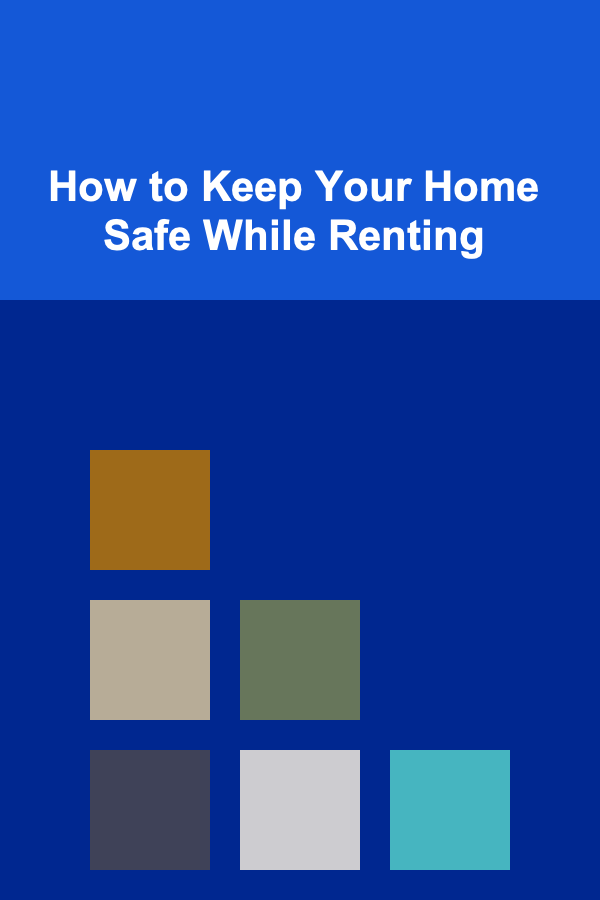
How to Keep Your Home Safe While Renting
ebook include PDF & Audio bundle (Micro Guide)
$12.99$11.99
Limited Time Offer! Order within the next:

Renting a home offers flexibility and convenience, but it also comes with its own set of challenges. One of the biggest concerns for renters is security. Unlike homeowners who can make permanent alterations to their property, renters must often find ways to secure their homes without violating lease agreements or facing unnecessary expenses. Ensuring your safety and the protection of your belongings in a rented property requires a bit of creativity, resourcefulness, and planning.
In this article, we will explore how renters can keep their homes safe while respecting the restrictions of their lease. From assessing the risks to implementing preventive measures, we'll cover a wide range of strategies that will help renters feel secure, whether they live in an apartment, a house, or a townhouse.
Assessing Your Security Risks
Before diving into the various security measures you can take, it's important to first assess the specific risks your rented home faces. Every living situation is unique, and your security needs may vary based on the location, layout, and type of property. Understanding these factors can help you identify which security measures will be most effective for you.
a. Location and Neighborhood
The first thing to consider is the location of your rental property. Is the neighborhood well-lit at night? Are there security concerns in the area? A high-crime area may require extra precautions, such as better lighting or a more robust lock system, compared to a quiet residential neighborhood.
You should also take into account the proximity of your rental to local amenities, public transportation, and how visible your property is to passersby. A home located on a busy street may face different risks than one situated on a secluded cul-de-sac.
b. Property Type and Layout
Next, evaluate the type of property you're renting. An apartment on the second floor will have different risks compared to a ground-floor unit or a standalone house. The layout of the property also matters; are there multiple entry points, like windows, balconies, or back doors? Properties with multiple access points may require additional precautions to secure those entrances.
c. Previous Security Issues
If you've just moved in, it's important to inquire about the property's history regarding break-ins or security concerns. Previous security issues might indicate vulnerabilities that need immediate attention. If the landlord hasn't addressed these problems yet, it's your responsibility to ensure your safety by taking extra steps to safeguard the property.
Strengthening Entry Points
One of the most critical areas to focus on when securing a rental property is the entry points. A burglar can easily access a home if doors and windows are not properly secured. Therefore, renters must make sure their entryways are as secure as possible.
a. Door Security
Many rental properties come with standard door locks that may not be sufficient to deter a determined intruder. To bolster door security, consider these options:
- Install a Deadbolt: If the property doesn't have one, installing a deadbolt is one of the most effective ways to secure doors. Deadbolts provide an extra layer of protection against break-ins, making it harder for burglars to force open the door.
- Reinforce the Frame: If possible, reinforce the door frame and hinges. Burglars often target weak door frames as they are easy to break. Adding metal reinforcements can prevent this.
- Use a Door Barricade: Some renters use door barricades, such as security bars or door wedges, to make it even harder for intruders to break in. These devices are easy to use and can be placed or removed without permanent alterations to the property.
- Peephole or Security Camera: Installing a peephole or a small security camera can help you monitor visitors before opening the door. This provides an added layer of safety, especially when you're not expecting anyone.
b. Window Security
Windows can be another vulnerable point in rental properties, especially if they are easily accessible from the ground or other external surfaces. Here are some tips for enhancing window security:
- Install Window Locks: Ensure all windows are locked properly when closed. In addition to the standard lock, you can purchase additional lock devices that prevent windows from being opened too wide.
- Use Window Bars: While some landlords may not approve of permanent alterations, window bars can be an effective way to prevent break-ins. There are temporary and removable window bars available, which can be a viable option for renters.
- Reinforce with Security Film: Window security film is a great option for renters. This film makes glass windows more resistant to shattering and can deter burglars from entering. It's a non-invasive solution that won't damage the windows and is easy to remove when you move out.
- Close Curtains or Blinds: Keeping curtains or blinds closed, especially at night, can prevent burglars from seeing inside. Avoid leaving valuable items like electronics or cash visible through the windows.
c. Sliding Doors and Patio Doors
Sliding doors are often less secure than standard hinged doors. If your rental has sliding doors leading to a patio or balcony, consider these security upgrades:
- Use a Security Bar: A security bar can be placed in the track of the sliding door to prevent it from being opened. Many sliding doors come with a track that can be easily manipulated, so a security bar offers an added layer of protection.
- Install a Reinforced Lock: Sliding doors are often equipped with weak locks. Adding a sliding door lock reinforcement can make the door harder to break into.
- Motion-Activated Lights: Install motion-activated lights outside your sliding doors or patio doors to deter potential burglars. Bright lighting in well-lit areas can discourage criminal activity.
Enhancing the Surrounding Area
Securing your home is not only about strengthening the entry points but also about ensuring the surrounding area is well-lit and free of hiding places that could give burglars an advantage.
a. Lighting
Outdoor lighting is one of the most effective deterrents against burglars. Criminals often prefer to work under the cover of darkness, so keeping your property well-lit can discourage them from targeting your home.
- Motion-Activated Lights: Install motion-sensor lights around your property. These lights will turn on automatically when they detect movement, which can startle potential intruders and draw attention to their presence.
- Lighting Around Entry Points: Ensure that all entry points, including doors and windows, are well-lit at night. This helps to make the area less appealing to burglars.
- Outdoor Pathway Lighting: Lighting up walkways or driveway areas ensures that you or anyone else approaching your home can see clearly, preventing surprise encounters.
b. Landscaping
Landscaping plays a big role in home security. Overgrown bushes and tall trees can provide cover for intruders, making it easier for them to approach your home undetected.
- Trim Shrubs and Trees: Keep bushes, trees, and shrubs around entry points trimmed to reduce hiding spots. Low shrubs and plants offer no concealment for intruders, making it easier to spot someone approaching your home.
- Fence and Gates: If the rental property allows it, consider installing a simple fence or gate around your yard. This can prevent unauthorized access to your property and add a layer of privacy.
Use Technology to Your Advantage
Today's technology provides renters with a variety of tools to monitor their home and enhance security. Many of these devices are affordable, easy to install, and require no permanent changes to your rental property.
a. Smart Home Security Systems
There are many smart home security systems that allow renters to monitor their property remotely. These systems typically include:
- Doorbell Cameras: Doorbell cameras, like Ring or Nest Hello, allow you to see who is at your door before answering, and you can communicate with visitors remotely via your smartphone.
- Cameras: Wireless security cameras can be placed inside and outside your home to monitor for suspicious activity. These cameras can be connected to your smartphone or computer, enabling you to check footage anytime.
- Smart Locks: Smart locks allow you to control access to your home through your phone or a code. This can be particularly useful if you're renting and don't want to deal with traditional keys.
b. Alarm Systems
While most landlords provide basic locks and security features, you may want to consider adding your own alarm system for added protection. Many alarm systems are now available in wireless or DIY versions that are easy to set up and take down when you move out. These alarm systems often come with monitoring options, which alert authorities if there's an attempted break-in.
Be Mindful of Insurance
Finally, renters should consider renters' insurance. While securing your home against theft and damage is important, renters' insurance provides an additional layer of protection for your belongings.
Renters' insurance covers your personal property in case of theft, fire, or water damage, and it also provides liability coverage. Having this insurance can give you peace of mind, knowing that if something goes wrong, you have financial protection in place.
Building a Community
Living in a rental property doesn't mean you have to face security concerns alone. Building a good relationship with your neighbors can be one of the best ways to keep your home safe.
- Neighborhood Watch: If your building or neighborhood has a neighborhood watch program, consider joining it. Participating in a watch group creates a network of individuals who can keep an eye on each other's homes and alert the authorities if something suspicious is happening.
- Stay Connected: Introduce yourself to your neighbors and maintain friendly communication. Neighbors who are familiar with you and your habits will be more likely to notice if someone is acting suspiciously around your home.
Conclusion
While renting a home comes with its own set of challenges when it comes to security, it's entirely possible to create a safe and secure living environment. By strengthening entry points, using technology, being mindful of the surrounding area, and considering insurance options, renters can take proactive steps to protect their homes and belongings. A combination of practical measures, thoughtful planning, and awareness will help ensure that your rented home remains safe, whether you are home or away.

Beginner Guide: How to Write a Business Plan
Read More
How to Create a Comprehensive Checklist for Hiring Employees
Read More
How to Make the Most of Your Attic for Storage
Read More
How to Update Your Bathroom Without a Full Remodel
Read More
How to Understand Different 3D Printing Filaments
Read More
Assembling Your Essential Baking Tool Kit for Beginners
Read MoreOther Products

Beginner Guide: How to Write a Business Plan
Read More
How to Create a Comprehensive Checklist for Hiring Employees
Read More
How to Make the Most of Your Attic for Storage
Read More
How to Update Your Bathroom Without a Full Remodel
Read More
How to Understand Different 3D Printing Filaments
Read More